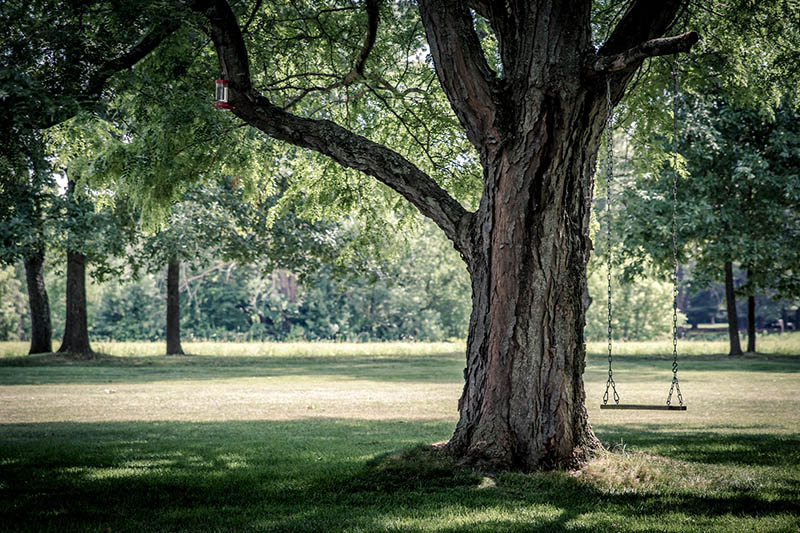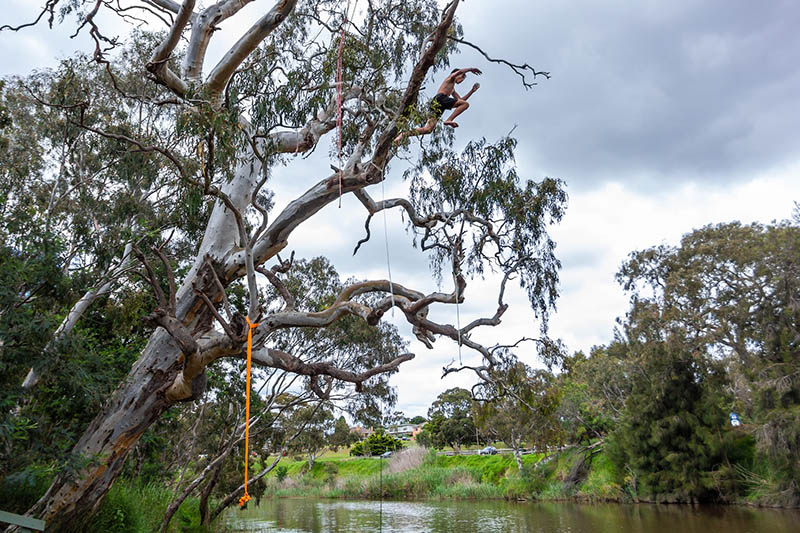How to Hang a Swing From a Tree: 6 Expert Tips
-

- Last updated:

If you’re lucky, your backyard is probably big enough for a tree. And if that tree has some branches low enough to support a swing, then that’s even better. If you have kids, you likely understand how much they like to play outside during the warmer months of the year. Having a swing in your backyard can be a great way for them to enjoy the weather and turn off extra energy.
Luckily, hanging a swing from a tree isn’t nearly as difficult as it sounds. While there are slightly advanced versions of this project that involve ladders or climbing trees with ropes and harnesses, there’s also an easier version that can be done by anyone who doesn’t mind getting their hands messy and using a bit of elbow grease. Let’s look at some tips on how to do it.
The 6 Expert Tips on How to Hang a Swing From a Tree
1. Choose the Right Tree for Hanging a Swing
First, you’ll need the right tree to hang your swing. There are a few factors to keep in mind when choosing your tree. The first is the age of the tree. Ideally, you should choose a tree that is at least 10 years old. Why? Because younger trees are more susceptible to disease, which can make them more difficult (and dangerous) to work with.
Also, a tree that’s too young may not have the strength and root system to support the weight of a swing. When looking at the tree, you should also keep in mind the diameter of the trunk.
A good rule of thumb is to make sure that the trunk is at least 2 feet in diameter. A smaller tree with little support in the trunk is likely to break if you try to hang a swing from it.

2. Make a List of Materials
While you don’t necessarily need many tools or materials to hang a swing from a tree, there are a few things you should have on hand before you start. First, make sure you have a large enough drill bit (or auger bit) to fit the rope through the branch. Next, you’ll also want to have long ropes that are long to go from the branch to the ground. Ideally, you want the ropes to be long enough so that the swing can sit about three feet off the ground.
You don’t want it to be too high that where people will have to make a high jump to get off of it, but you also don’t want anyone’s feet to drag on the ground while on it. And note that you’ll need to include a few extra feet to account for support knots.
You can usually find a long enough rope at a hardware store or home improvement store such as Lowe’s or Home Depot. You also need to purchase the swing itself. Some swings come in kits that include everything you need for the project. You can also build the actual swing portion yourself with a few pieces of 2×4 wood and some nails or screws.
Finally, get safety goggles and workers’ gloves to protect your eyes and hands from the bark and rough edges of the branch. The rope should be at least 1/2 inch in length. A rope that’s thick enough to support an adult’s weight should be strong.
What Type of Rope Is Best?
For its strength and durability, braided polyester is the best synthetic rope you can get. While nylon rope is strong, it can stretch easily and be slippery. Polypropylene ropes are more resistant to the elements. And ropes made of natural fiber absorb moisture and rot over time. They should be replaced every one to two years.
3. Choose the Right Location
You’ll need to find the right location on the tree, and some trees may only have one or two locations where this is viable – it’s usually the strongest (or thickest) branches. The branch should be long enough to support the swing, but no longer than 5-6 feet – this may make it more susceptible to breakage.
You’ll also want to make sure that the branch is healthy and strong enough to support the weight of the swing. One way to do this is to pull or hang from the branch and look for signs of weakness or instability. If the branch has lots of cracks in it or seems to be bending or sagging, it’s a good idea to find a different location for your swing.

4. Cut Away Extra Limbs and Branches
Once you’ve found the right location for the swing, you’ll need to remove any extra branches or stems coming from the main branch that you’re going to hang your swing on. You can do this using a hand or electric saw, or even a pair of shears if the branches are small enough. Ultimately, you want to make sure that the area where the ropes and support will go is completely accessible.
5. Install Enough Support
The way that you install support will depend on the type of swing that you have and the amount of additional support that you want. Whether you have a tire, saucer, or traditional saddle swing, it always helps to have support.
Once you’ve cut the branch, you can use a mallet or hammer to drive a wooden dowel through the holes in the branch. This will help to stabilize the branch and hold it in place. Next, you can use a carpenter’s knot to secure the rope.
This is simply a series of knots that will keep the rope from sliding through the branch. Or, you can simply wrap the two pieces of rope around the branch, ensuring that they’re the width of the swing seat itself (or wherever the holes are in the size of the swing). If your ropes are already attached to the swing itself, you’re good to go.

6. Install the Swing and Test It
Test the swing to make sure that the swing is level and that it swings smoothly and doesn’t rock side to side. The branch of the tree should not shake or wobble while you’re on the swing. If it does, it’s best to remove the swing and try another branch. In some cases, you can also install an artificial branch on the tree if there are no good branches available.
Types of Swings
Tree swings are available in many styles, both for children and adults. You can have one or two riders on a single or double-rope swing. Let’s take a look at some of the most common ones in the market today.
Traditional Swings
Traditional tree swings consist of two ropes, chains, and a seat that’s usually made of wood or sturdy plastic. While flexible seats are safer for younger users, older children and adults prefer rigid seats for their greater comfort.
Rope Swings

Rope swings can be made from a single long rope. Often, the rope is passed through a disc before being knotted underneath. To safely use them, they require greater strength and dexterity, which is why these particular swings are only recommended for people over 10 years old.
Multi-person Swings
Multi-person swings can be supported by either a single or double-rope system. Saucer swings are the most common type of multi-person swing, named after their disc-shaped seats. These convenient swings offer a greater range of motion (not just back and forth), similar to rope swings.
Bucket Swings
These swings are for toddlers and babies and are made to allow them to move in a gentle, controlled back-and-forth manner. Essentially, they “fit” like a pair of shorts with a top-entry design, which protects children from sliding out of their seats during playtime. There are many options available, including single and double-rope designs with various secure platform styles.
Final Thoughts
Hanging a swing from a tree is a great project for beginners. While it will definitely get your hands a little dirty, it’s a project that can be completed by almost anyone, regardless of skill level. If you have the right tools and a steady hand, you can easily make your backyard even more fun for kids and adults alike.
Before installing a swing on a tree, be sure to make a list of all the materials that you need and establish enough support on the branch to ensure the safety of anyone who uses the swing.
Featured Image Credit: Ryan Hafey, Unsplash
Contents



